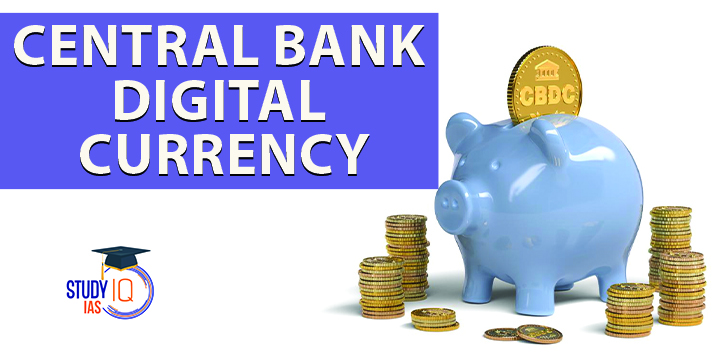Table of Contents
What is Central Bank Digital Currency in India?
Central Bank Digital Currency CBDC or digital rupee or e-rupee is the digital version of fiat currency issued by the RBI and is exchangeable one-to-one with the fiat currency.
The currency can be accepted as a medium of payment, legal tender and a safe store of value.
The e-rupee would appear as liability on a central bank’s balance sheet and not that of commercial banks.
Central Bank Digital Currency RBI Categories
- Retail (general purpose): The CBDC-Retail (CBDC-R) will be the digital version of cash primarily meant for retail transactions. It can be used by private sector, non-financial consumers and businesses.
- However, how e-rupee can be used in merchant transactions in the retail trade has not been explained.
- Wholesale: The CBDC-Wholesale (CBDC-W) will have restricted access to select financial institutions. It can be used for settlement of interbank transfers and other large transactions.
Central Bank Digital Currency List
- Token-based: A token-based Central Bank Digital Currency RBI would be a bearer instrument like banknotes. Individual holding the tokens at a given point in time would be presumed to own them.
- This form is viewed as a preferred mode for CBDC-R as it would be closer to physical cash. The receiver will have to verify if sender’s ownership of token is genuine.
- Account-based: An account-based Central Bank Digital Currency will require maintenance of record of balances and transactions of all holders of the CBDC and indicate the ownership of the monetary balances.
- An intermediary will verify the identity of an account holder. This system is more suitable for CBDC-W.
Central Bank Digital Currency Model of Issuance
- Direct model (single tier): In this model, the central bank will be responsible for managing all aspects of the digital rupee system such as issuance, account-keeping and transaction verification.
- Indirect model (two-tier): In this model, the central bank and other intermediaries (banks and any other service providers), will have important role.
- The central bank will issue Central Bank Digital Currency CBDC to consumers indirectly through intermediaries and any claim by consumers will be handled by the intermediary.
Central Bank Digital Currency Pros
- Risk-free virtual currency: The e-rupee would provide public a risk-free virtual currency that will give them legitimate benefits without dealing in private virtual currencies.
- Reduce operational costs: The Central Bank Digital Currency will help in reduction in operational costs involved in physical cash management.
- Over-haul of payments system: The CBDC will help in bringing resilience and efficiency in the payments system as CBDC is cheaper to operate and can work under challenging circumstances.
- Reduce illicit money: Cash can be used anonymously, without leaving audit trail. CBDC will be monitored by central bank, thus reducing use of illicit money.
- Off-line capabilities: The RBI is ensuring that CBDC have offline capabilities to make it a more attractive and accessible medium of payment.
- Financial inclusion: It will facilitate easy availability of credit to unbanked population in the financial system. This is possible through increasing access to digital payments.
Central Bank Digital Currency Cons
- Offline functions: There is a risk of ‘double-spending’ in offline mode. A CBDC unit can be used more than once without updating the common ledger of Central Bank Digital Currency .
- However, there are technical solutions to prevent double-spending. Limits can also be imposed on offline transactions.
CBDC vs Cryptocurrency
| CBDC | Cryptocurrency |
| CBDC is entirely centralized, even though it uses blockchain. | Cryptocurrency use decentralized network for operation. |
| They are controlled by central bank and considered legal tender. | They are privately backed assets and may or may not be considered legal tender. |
| CBDC will be the digital version of fiat currency and will be backed by central Bank’s assets. | They are not backed by any underlying asset. |


 Payments Regulatory Board (PRB)
Payments Regulatory Board (PRB)
 OPSC OCS Notification 2026 Out: Apply On...
OPSC OCS Notification 2026 Out: Apply On...
 UPPSC LT Grade Admit Card 2025 Out @upps...
UPPSC LT Grade Admit Card 2025 Out @upps...

























